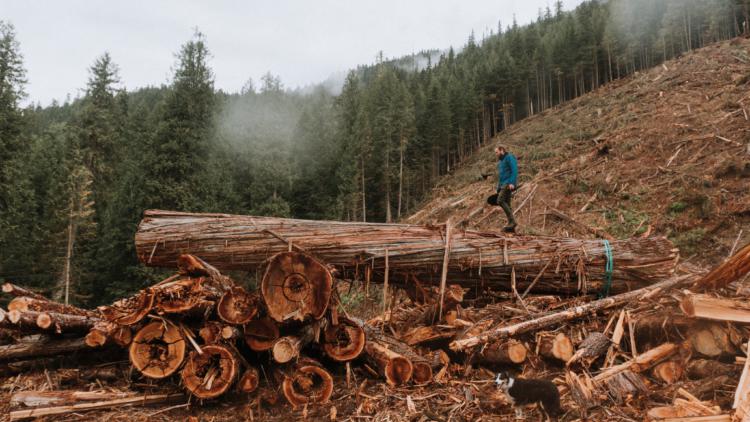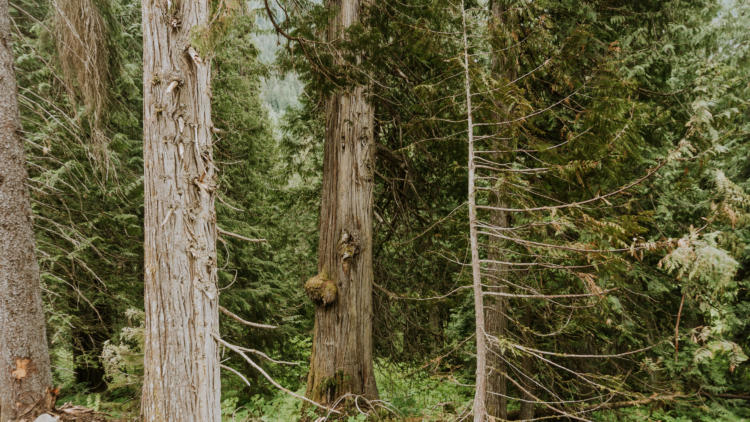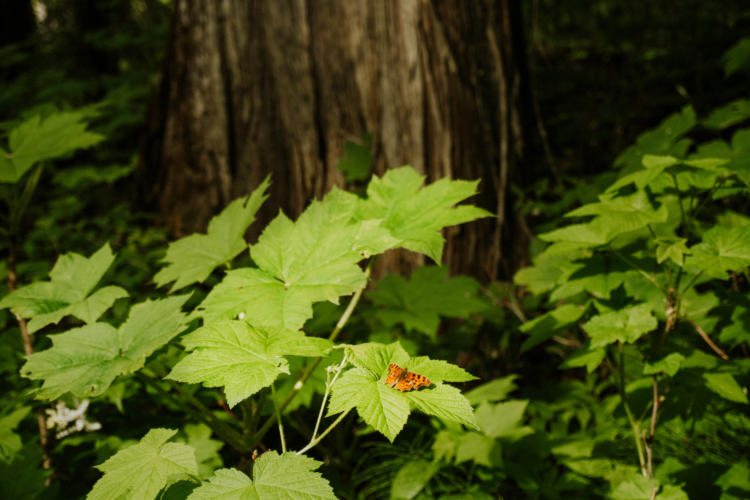British Columbia markets itself as “supernatural BC” and yet we are one of the last jurisdictions in the world still logging irreplaceable old growth forests on public lands.
As citizens across BC put their bodies on the line to protect old growth forests, we have to collectively ask ourselves: how did we get to this point? How are we in the same situation as we were during the War of the Woods in the ‘90s? That movement ended old growth logging in most of Clayoquot Sound, but did little to end the practice in other parts of BC. The fight for BC’s forests is often pitted as a battle between resource workers and environmentalists. Meanwhile, the policy failures and corporate agendas responsible for the current state of BC’s forests rarely make the headlines.
I’m writing this in the hope that these topics will change how you think about the old growth conversation. I’m writing this because I believe that future generations deserve a chance to experience the supernatural forests of BC which continue to get loaded on logging trucks every day.

The Devil is in the Details
BC’s biodiversity strategy is almost exclusively reliant on old growth forest. Biodiversity is simply all of the living things that make this province so special. Old growth is one of the only things we manage at a provincial scale for biodiversity. Simply put, if we are failing old growth at a provincial scale, we are likely failing frogs, caribou, bull trout, salmon, and all of the critical living things that we collectively refer to as “biodiversity”.
In the ’90s, BC embarked on land use planning through the Commission on Resources and Environment. These locally-led land use tables provided a plan and a benchmark for how regions would manage natural resources including old growth into the future. But as Gary Merkel, professional forester and Tahltan Nation member stated in a recent interview with the Narwhal, the original Kootenay Boundary and Revelstoke Land Use plan(s) old growth targets were dramatically reduced with one stroke of the pen. This is what is often referred to as “the drawdown”.
In these two areas old growth retention targets were reduced by ⅔ in low biodiversity emphasis areas (45 percent of the landscape). For example, if the original target for old growth retention for logging companies was to conserve 12 percent of the low elevation old growth cedar-hemlock forests in one area, after the drawdown was implemented the legal target became 4 percent. In essence, with one change, logging companies only had to preserve one-third of the original target in nearly half of the landscape in the Kootenay-Boundary and Revelstoke area. This drawdown has resulted in the sacrifice of some of the most important low elevation old growth forests.
In 2011, the Revelstoke area requirements for old growth were once again weakened in order to compensate logging companies for caribou protections. The changes enabled licensees to place old growth management areas outside of the timber harvesting land base and freed up previously protected or constrained old growth forest for logging. In all, the amendment made 7,049 hectares, or more than 8,000 soccer fields, worth of previously protected or constrained old and mature forest available for potential logging (FPB 2013). A 2013 report from the Forest Practices Board stated that the 2011 changes to the Biodiversity requirements “will result in less older forest retained overall, particularly within the lower elevation ICH BEC [Interior Cedar Hemlock Biogeoclimatic] zone. Logging these areas will likely act to fragment ecosystem connectivity and may make caribou recovery more difficult”.

Existing Protections Are Not Effective
In 2018, the West Kootenay Ecosociety launched a formal complaint to the province that old growth forests in the Kootenay Lake and Arrow Timber Supply Areas were not being effectively protected in old growth management areas, and that the province was failing to meet already weakened legal old growth targets set out in the Kootenay and Boundary Higher Level Plan Order.
The province did a formal analysis and found licensees were in deficit for old growth in 47 areas of the Arrow and Kootenay Lake Timber Supply and likely not meeting the legal requirements for old growth set out in Land Use Plans.
They also found that only 17 and 18 percent of forests in old growth management areas (OGMA) are actually composed of old growth forest. The vast majority of forests in old growth reserves in these two timber supply areas (TSA’s) are composed of young, middle, and mature aged forests. This equates to a massive shortfall of 76,000 ha of old forest in OGMA in the Arrow TSA and nearly 36,000 ha in the Kootenay Lake TSA (MacKillop 2018).
Old growth management areas are intended to conserve old growth forests, but the current management of OGMA in these two areas highlights policy failures big enough to drive a logging truck through. The province is likely to address the 47 legal deficits but has not set out an intention to address the massive shortfall of thousands of hectares of old growth management areas that are not composed of old growth forests in the Kootenay Lake and Arrow TSA’s.
These two case studies are just two examples of how we are failing old growth even within the little protection we do have here in the Kootenay and Columbia regions. There are many more throughout the province, including a damning recent report from the BC Forest Practices Board on BC Timber Sales failing to comply with laws protecting old growth in the Nahmint Valley on Vancouver Island.

An Opportunity For Change
We will soon learn what the old growth technical review panel will recommend in order to stop the bleeding caused by decades of logging irreplaceable old growth forests. Industry lobby groups are already attempting to dismiss the findings of the old growth technical review panel and delay action further.
The rubber will hit the road with a new round of old growth deferrals expected early this fall. The province must show leadership in order to rebuild the deep distrust that has been sewed by years of old growth policy failures.
As citizens continue to put their bodies on the line at blockades around the province to protect rapidly disappearing old growth forests, the BC NDP must show leadership and act on the science and recommendations from the old growth technical review panel. Otherwise, “supernatural BC” will continue to be known as one of the last jurisdictions in the world still logging irreplaceable old growth forests.



